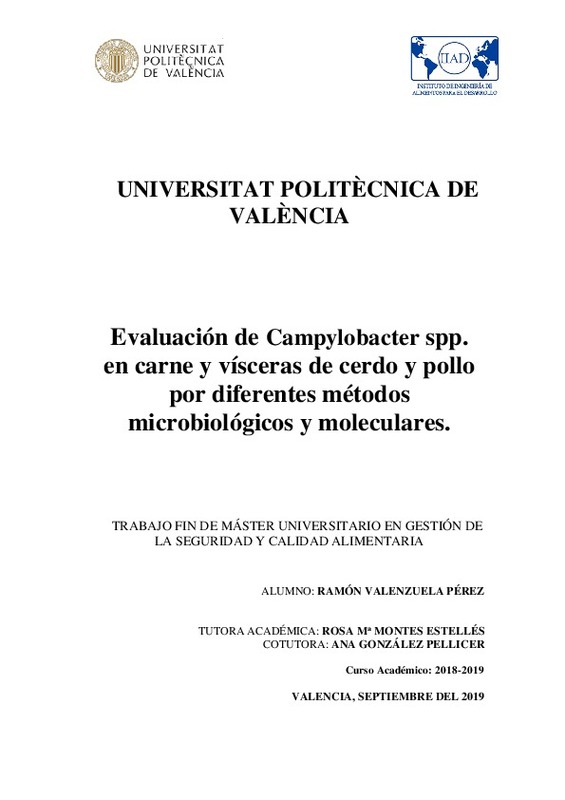JavaScript is disabled for your browser. Some features of this site may not work without it.
Buscar en RiuNet
Listar
Mi cuenta
Estadísticas
Ayuda RiuNet
Admin. UPV
Evaluación de Campylobacter spp. en carne y vísceras de cerdo y pollo por diferentes métodos microbiológicos y moleculares
Mostrar el registro sencillo del ítem
Ficheros en el ítem
| dc.contributor.advisor | Montes Estellés, Rosa Mª
|
es_ES |
| dc.contributor.advisor | González Pellicer, Ana
|
es_ES |
| dc.contributor.author | Valenzuela Pérez, Ramón Isael
|
es_ES |
| dc.date.accessioned | 2019-10-25T13:07:13Z | |
| dc.date.available | 2019-10-25T13:07:13Z | |
| dc.date.created | 2019-09-27 | |
| dc.date.issued | 2019-10-25 | es_ES |
| dc.identifier.uri | http://hdl.handle.net/10251/129694 | |
| dc.description.abstract | [ES] El análisis microbiológico de Campylobacter spp. en alimentos es una técnica complicada, tanto por las necesidades de microaerofilia, como por la dificultad del aislamiento de estas bacterias en los medios de cultivo, debido a la gran cantidad de microbiota que puede crecer en este tipo de análisis, por ello analizamos las muestras tanto por métodos clásicos de detección por cultivo como por técnicas moleculares. Con el objetivo de comparar las técnicas clásicas y moleculares de diagnóstico Campylobacter spp. se realizó el análisis de microbiología clásico utilizando el método descrito por la Norma internacional UNE-EN-ISO 10272-1: 2018, en la que se analizó la presencia o ausencia de campylobacterias termotolerantes Posteriormente se realizó la detección directa a partir del caldo de enriquecimiento mediante PCR múltiplex, sin necesidad de aislar la bacteria. Se analizaron un total de 40 muestras de cerdo y 20 muestras de pollo, procedentes de diferentes puntos de venta y distribución de la ciudad de Valencia (España). En muestras de cerdo, Campylobacter spp. pudo detectarse únicamente en tres de las muestras por PCR directa (3/40) y sólo una de ellas dio positiva por cultivo. En las muestras de pollo, se obtuvieron porcentajes de detección mucho mayores, 14 de las 20 muestras fueron positivas por PCR (14/20). Sin embargo, sólo 2 de ellas resultaron positivas por cultivo en placa. Los resultados muestran elevados porcentajes de contaminación en muestras de pollo y la importancia de la utilización de las técnicas moleculares, dada su mayor sensibilidad, en la detección de Campylobacter spp. Esto genera la necesidad de difundir el uso de las técnicas moleculares en la industria agroalimentaria. | es_ES |
| dc.description.abstract | [EN] The microbiological analysis of Campylobacter spp. in food it is a complicated technique, both for the needs of microaerophilia, and for the difficulty of isolating these bacteria in the culture media, due to the large amount of microbiota that can grow in this type of analysis, so we analyze the samples both by classical methods of detection by culture and by molecular techniques. In order to compare the classic and molecular diagnostic techniques Campylobacter spp. The classic microbiology analysis was performed using the method described by the International Standard UNE-EN-ISO 10272-1: 2018, in which the presence or absence of thermotolerant campylobacteria was analyzed Subsequently, the direct detection was made from the enrichment broth by multiplex PCR, without the need to isolate the bacteria. A total of 40 pig samples and 20 chicken samples, from different points of sale and distribution in the city of Valencia (Spain), were analyzed. In pig samples, Campylobacter spp. it could only be detected in three of the samples by direct PCR (3/40) and only one of them was positive per culture. In chicken samples, much higher detection percentages were obtained, 14 of the 20 samples were positive by PCR (14/20). However, only 2 of them were positive per plate culture. The results show high percentages of contamination in chicken samples and the importance of the use of molecular techniques, given their greater sensitivity, in the detection of Campylobacter spp. This generates the need to spread the use of molecular techniques in the industry. agri-food | es_ES |
| dc.format.extent | 23 | es_ES |
| dc.language | Español | es_ES |
| dc.publisher | Universitat Politècnica de València | es_ES |
| dc.rights | Reserva de todos los derechos | es_ES |
| dc.subject | Campylobacter | es_ES |
| dc.subject | Food microbiology | es_ES |
| dc.subject | Polymerase chain reaction | es_ES |
| dc.subject | Chicken meat | es_ES |
| dc.subject | Pork | es_ES |
| dc.subject | Reacción en cadena de la polimerasa | es_ES |
| dc.subject | Microbiología de los alimentos | es_ES |
| dc.subject | Carne de pollo | es_ES |
| dc.subject | Carne de cerdo | es_ES |
| dc.subject.classification | MICROBIOLOGIA | es_ES |
| dc.subject.other | Máster Universitario en Gestión de la Seguridad y Calidad Alimentaria-Màster Universitari en Gestió de la Seguretat i Qualitat Alimentària | es_ES |
| dc.title | Evaluación de Campylobacter spp. en carne y vísceras de cerdo y pollo por diferentes métodos microbiológicos y moleculares | es_ES |
| dc.type | Tesis de máster | es_ES |
| dc.rights.accessRights | Abierto | es_ES |
| dc.contributor.affiliation | Universitat Politècnica de València. Departamento de Biotecnología - Departament de Biotecnologia | es_ES |
| dc.contributor.affiliation | Universitat Politècnica de València. Escuela Técnica Superior de Ingeniería Agronómica y del Medio Natural - Escola Tècnica Superior d'Enginyeria Agronòmica i del Medi Natural | es_ES |
| dc.description.bibliographicCitation | Valenzuela Pérez, RI. (2019). Evaluación de Campylobacter spp. en carne y vísceras de cerdo y pollo por diferentes métodos microbiológicos y moleculares. http://hdl.handle.net/10251/129694 | es_ES |
| dc.description.accrualMethod | TFGM | es_ES |
| dc.relation.pasarela | TFGM\113233 | es_ES |
Este ítem aparece en la(s) siguiente(s) colección(ones)
-
ETSIAMN - Trabajos académicos [3541]
Escuela Técnica Superior de Ingeniería Agronómica y del Medio Natural






